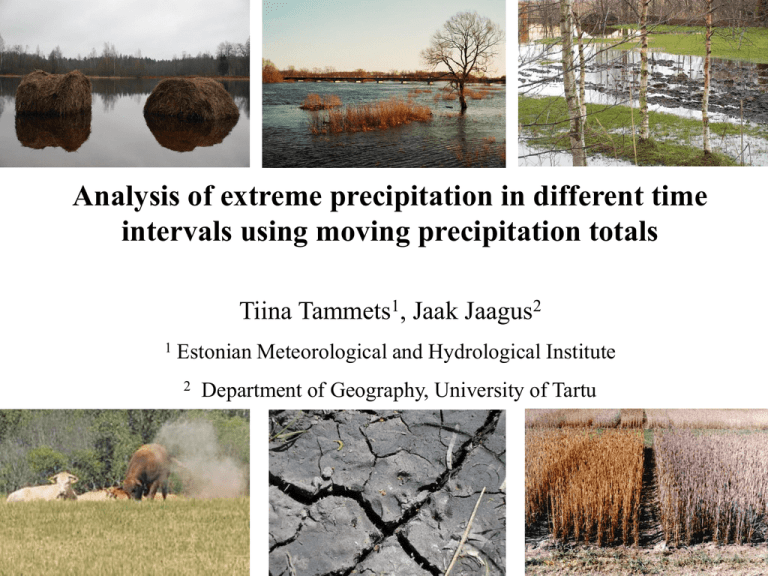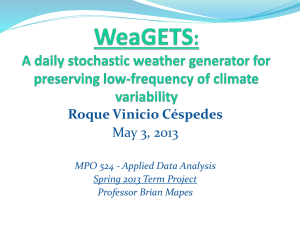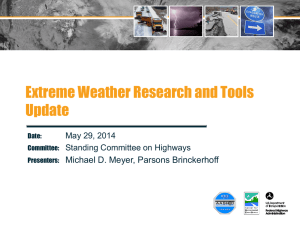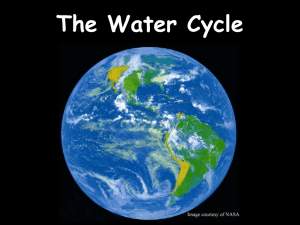Estimation of extreme wet and dry days through moving totals in
advertisement

Analysis of extreme precipitation in different time
intervals using moving precipitation totals
Tiina Tammets1, Jaak Jaagus2
1
Estonian Meteorological and Hydrological Institute
2
Department of Geography, University of Tartu
Outline
• Introduction, precipitation regime and extremes in Estonia
• Overview of the characteristics used for description of
precipitation extremes
• Objectives of the study
• Using of moving precipitation totals as characteristics of
precipitation regime
• Extreme precipitation in Estonia in dependence of a
number of days and months in observed period
• Extreme precipitation in Estonia in case of very wet and
dry conditions during 1957-2006
• Trends in precipitation extremes in Estonia during 19572006
• Conclusions
Annual curve of monthly mean, maximum and
minimum precipitation in 1966-2009, mean of
the meteorological stations in Estonia
160
140
average
precipitation, mm
120
min
max
100
80
60
40
20
0
I
II
III
IV
V
VI
VII
VIII
IX
X
XI
XII
Precipitation in July and August 1966-2009,
mean of the meteorological stations in
Estonia
180
August
2008
July
160
1987
1978
1988
1990
2005
120
1996,
1994 1997
100
2002
1983
2006
80
60
40
20
2008
2006
2004
2002
2000
1998
1996
1994
1992
1990
1988
1986
1984
1982
1980
1978
1976
1974
1972
1970
1968
0
1966
precipitation, mm
140
JUNE
PRECIPITATION 2009
IN ESTONIA
AUGUST
JULY
Characteristics used for description of
precipitation extremes
• quantiles of precipitation amounts;
• maximum number consecutive wet days (R>= 1 mm; 10
mm);
• maximum number of consecutive dry days with the
threshold of 0.1 mm; 1 mm precipitation;
• number of heavy precipitation days in a month or year
(R>=10 mm);
• number of very heavy precipitation days (R>=20 mm);
• number of dry and wet days in a month or in a year with
chosen threshold;
• mean wet-day and dry-day persistencies;
• hydrothermical coefficient.
hydrothermical coefficient (HTK) :
HTK = Precipitation / 0,1* Temperature
Hydrotermical coefficient, average of Estonian meteorological stations
June-August 1961-2009
90
80
1998
1962
1978
70
1981
1987
HTK, mm/°C
1990
1961
1974
1965
1964
1971
1967
2001
1986
1984
1970 1973
1968
1975
1969
1983
0
2005
2003
1979
1982
1977
1976
2007
1995
1994
1992
20
10
2009
1985
40 1963
30
2008
2004
60
50
1993
HTK = R/0,1*T
2002
1999
2006
For many purposes it is essential
not to show how much it rains in a day
but
to show how much has been
rained till this day
A day will be extreme day, if the amount of precipitation till
this day has been too small or too large.
Objectives
• To define characteristics describing continuous dry and wet
spells with various duration, which doesn’t divide time into
months or 10-day periods
• To elaborate a method characterising climatology of
extreme precipitation totals for any time periods (number
of following days, months or years using moving totals)
• To detect the most severe wet and dry spells in Estonia
during last 40-50 years and to analyse trends in days with
precipitation extremes
To find the number of extreme days we have to calculate the moving total or
average of precipitation time series
CALCULATING MOVING TOTALS (AVERAGES)
Mathematically the sequence of moving totals (averages){sj(n),1 j N-n+1} is
derived from a sequence {ai, 1 i N} obtained by taking the totals (averages)
of the subsequent n terms:
i n1
sj(n)= aj (by moving averages
j i
in1
sj(n)=1
n
aj),where N is the total number of days
ji
in the precipitation time series and n the number of days through which the
moving average is calculated. We find drought and wet days by calculating sj(n)
with time period n for each day i in the time series and choosing the days with
values of sj(n), that are smaller or larger than the given threshold t.
Counting of moving total
if there are no
precipitation on
a day and
previous n
days the day
has been
counted as a
droughtday
n
days
1
2
3
4
5
6
7
8
9
10
11
12
13
14
15
16
days
1
2
3
4
5
6
7
8
9
10
11
12
13
14
15
16
17
18
19
20
17
21
21
22
23
22
23
N days
18
19
20
if the average of
precipitations on
a day and
previous n days
is M mm and
more the day has
been counted as
a
p
wetday
n
Presentation of the extreme precipitation in any
number of days, months or years
600
Jõgeva max
Jõgeva min
Poly. (Jõgeva max)
Poly. (Jõgeva min)
precipitation, mm
500
400
300
200
100
0
0
20
40
60
80
100
number of days
120
140
Precipitation stations in Estonia
Extreme totals of precipitation for any number of days during 1966-2009 has
been found in Tallinn, Vilsandi, Väike-Maarja, Võru Tartu and Pärnu stations
Dependence of maximum and minimum precipitation on the
number of successive days at six stations in Estonia in 1966-2009
Extreme precipitation totals in Estonian climate stations in 1966-2009
1200
TALLmax
V-MAARmax
PÄRNUmax
TÕRAmax
VILSmax
VÕRUmax
TALLmin
V-MAARmin
PÄRNUmin
TÕRAmin
VILSmin
VÕRUmin
precipitation, mm
1000
800
600
400
200
0
0
50
100
150
200
250
number of days
300
350
400
Dependence of maximum and minimum precipitation on the number
of successive months at six stations in Estonia in 1966-2009
Extreme precipitation totals 1966-2009 in Estonian climate stations
4500
pärnumax
v-maarjamax
tallinnmax
võrumax
vilsandimax
tõraveremax
4000
precipitation, mm
3500
3000
pärnumin
v-maarjamin
tallinnmin
võrumin
vilsandimin
tõraveremin
5 years
4 years
3 years
2 years
2500
1 year
2000
1500
1000
500
0
0
10
20
30
number of months
40
50
60
Extremely wet and dry days for Estonia
In agrometeorological studies of Estonia, the criterion of
extremely wet conditions - mean daily precipitation 10 mm
or more during successive 10 days is used.
If the moving average for a 10-day period sj (10)>= 10 mm,
then the last day of the period is regarded as a wet day.
Extremely dry conditions for field plants mean that there is
no precipitation during successive 20 days; then sj (20) = 0
and the last day of the period has been counted as a dry day.
number of
day
1
2
3
4
5
6
7
8
9
10
11
12
13
14
15
16
17
18
19
20
21
22
23
24
25
26
27
28
wet
dry
criteria:
average
10 mm in a day
without
precipitation
• extremely wet conditions:
when the mean daily
amount of precipitation is
10 mm and more during 10
consecutive days
1. wet day
1. dry day
• extremely dry conditions:
no precipitation during 20
consecutive days
Monthly relative number of wet days and days with
precipitation ≥10 mm during 1957-2006, mean of
the meteorological stations in Estonia
wetdays
days with precip.10mm and more
0,40
0,35
0,30
0,25
0,20
0,15
0,10
0,05
0,00
I
II
III
IV
V
VI
VII
VIII
IX
X
XI
XII
Monthly relative number of dry days and days
without precipitation during 1957-2006, mean of
the meteorological stations in Estonia
0,25
drydays
days without precipitation
0,20
0,15
0,10
0,05
0,00
I
II
III
IV
V
VI
VII
VIII
IX
X
XI
XII
Maximum number of dry days in Estonia from May
to August during 1957-2006
16
14
24
12
13
13
24
11
26
23
10
15
14
14
9
22
10
21
8
15
12
10
10
15
7
8
10
10
26
17
23
17
26
22
22
22
14
17
5
7
13
10
18
8
23
18
15
8
11
23
12
10
10
30
wetdays
0,14
12
drydays
0,12
10
8
relative number of extremes
Linear (relative number of extremes)
0,10
0,08
6
0,06
4
0,04
2
0,02
0
0,00
Relative number of extreme
(dry+wet) da ys
14
1957
1959
1961
1963
1965
1967
1969
1971
1973
1975
1977
1979
1981
1983
1985
1987
1989
1991
1993
1995
1997
1999
2001
2003
2005
Number of days
Number of wet and dry days (mean of 56 stations)
and relative number of extreme (wet+dry) days in
1957-2006
Conclusions
The method of moving precipitation totals allows to
1. present maximum and minimum precipitation in different periods
(from 1 day to 4-5 years) on graph, which gives complete
information about precipitation extremes of a station. It allows
also to compare extreme precipitation amounts in different
stations for every time period.
2. connect precipitation extremes with the dynamics other
characteristics of hydrological regime (for example soil moisture
content, ground water level, river runoff etc.) and find the best
predictants of precipitation regime for extreme situations of
environment
3. extract the time intervals of extreme precipitation events to relate
them to atmospheric circulation
Conclusions
Using of the method of moving precipitation totals for the
analysis of precipitation extremes in Estonia demonstrated that
• maximum and minimum precipitation in case of any number
of successive days and months on the coast of open sea
(Vilsandi) is significantly lower than in the continental Estonia
• occurrence of wet days is the highest in July and August
while the number of dry days is maximal only in August and
much lower in July
• maximum number of days without precipitation has been
observed in May
• total number of extreme (wet and dry) days in Estonia has
increased significantly during 1957-2006









